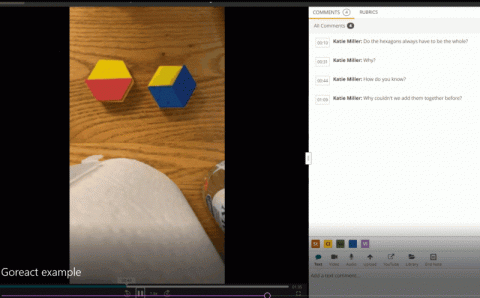Introduction
When the pandemic forced our in-person courses to swiftly switch to remote classes in April 2020, like many other educators, one of my first concerns as an instructor for math content courses was, how can I make sure PSTs aren’t cheating when taking tests? It should not have been my first worry, but in the chaos and uncertainty of the time, it felt like the most tangible piece of my course that I could try to control. I experimented with two different types of assessments that semester: one was a “mad-libs” style test where PSTs had to come up with the numbers to fill in the blanks in problems (see image for example), and the other had PSTs analyze homemade videos (from my friends and family) of children solving math problems. While both of these approaches had some benefits, neither one seemed to give me much insight into how well my PSTs understood concepts in a visual manner, which is key for elementary educators (Hill & Ball, 2009).
What is GoReact?
For this past fall, I continued with the same assessments even though I was not thrilled with the outcomes. At the same time, I happened to be looking for a platform to support my university supervisors in their observations of our PSTs, and I ran across GoReact. (Let’s be honest… I “ran across” it because a colleague referred me - we both would get a coffee gift card if I sat through a sales pitch, and who doesn’t want more coffee??) GoReact is a video annotation platform that allows users to upload videos and then get time-stamped feedback using predetermined tags or written comments. It also works with live video, which I was thinking would be great for our supervisors who were observing remotely. During the sales consultation (while dreaming of the delicious unhealthy coffee-like drink I was going to purchase), I realized that the videos users uploaded didn’t need to be recordings of them teaching; the videos could be my PSTs explaining processes and visuals and actions. What I had been missing in my assessments, even pre-pandemic, was a focus on the dynamic, visual ways that PSTs come to understand and explain elementary mathematics concepts. There was always an over-reliance on symbolic notation, procedure, and static visuals, even though I am adamantly against those as the focus of any math class. Suddenly, I realized that I could use video as an opportunity to assess my PSTs’ understanding of not just visual representations of concepts, but of the physical movement that often accompanies those visuals.
I rewrote my assessments for my number sense class this semester with prompts that the PSTs had to respond to using video. They were expected to use manipulatives and action to explain in multiple ways what we mean when we’re asked to find a common denominator, or how to regroup when subtracting whole numbers. Each prompt was uploaded as a separate video, and I was able to leave detailed feedback. The feedback is the key to GoReact. I could have easily had my students upload the videos to Google Classroom or via Blackboard (for free) but then I’m left figuring out how to give them specific, detailed feedback in response to their videos. GoReact allows you to create tags ahead of time, or to write comments that, when the video plays back for the PST, show up in real time.

Benefits and Reactions
GoReact gave my PSTs not only a chance to show deep understanding of number sense concepts, it also provided a great platform for me to give specific, detailed feedback. It also inadvertently addressed my concerns with cheating; by allowing PSTs to think through the problems ahead of time, they felt less pressure to seek out the answer instead of figuring it out for themselves. There was also a noticeable difference for some PSTs; they might have struggled with the written problems throughout the semester, but were able to communicate much more clearly through video and being able to move the manipulatives around instead of trying to draw pictures. Teachers should be flexible with all types of representations, including static pictures and symbolic notation, but by using the video responses, my PSTs had an opportunity to also work with a different, more dynamic representation.
Moving Forward
Yes, it’s a little expensive, especially if you are not using the platform program-wide. My plan is to start by using this regularly in my face-to-face content classes this year, designing take-home assessments, and then hopefully expand the use of the platform throughout our program. More important than the specific platform though is how my understanding of assessment has grown and adapted throughout the last three semesters. There’s not much from our pandemic way-of-life that we should hold on to, but changing our mindset about assessment needs to be here to stay. That, and wearing pajama bottoms to work every day.
Reference
Hill, H., & Ball, D. L. (2009). The curious—and crucial—case of mathematical knowledge for teaching. Phi Delta Kappan, 91(2), 68-71.


Add new comment